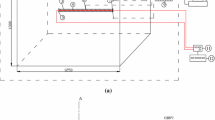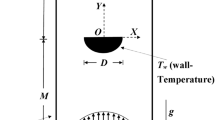Abstract
A study of thermal conductivity measurements of fluids, using the technique of steady-state heat transfer in concentric cylinders, is presented. In order to evaluate the effect of convective flow on the measured value of conductivity, numerical results, which were obtained using computational fluid dynamics (CFD) in three dimensions, are compared with experimental data and analytical results of temperature profiles. This latter was obtained considering the hypothesis of heat transfer mechanism being entirely diffusive and solely in the radial direction. An experimental design was proposed aiming to analyze the effects of glycerol mass fraction (0%, 50 and 100%), annuli size (2.525, 4.525 and 6.525 mm) and heat rate (5, 10 and 15 W) in the formation of convective streamlines. The ratio between effective and absolute conductivities (kef/k) was used as a response to evaluate the convection intensity. The results were compared with empirical equations that correlate the ratio kef/k with the dimensionless numbers of Prandtl and Rayleigh, which are in the rate 4.37 ≤ Pr ≤ 3.8 × 103 and 9.0 ≤ Ra ≤ 4.4 × 104. An evaluation of the accuracy in measuring kef is showed based on the simulated data of temperature profiles in the axial, radial and angular directions.









Similar content being viewed by others
Abbreviations
- Symbol:
-
Meaning Unit (I.S.)
- A :
-
Area of heat transfer: m2
- b :
-
Coefficients of the multiple regression equation: dimensionless
- C, m :
-
Correlating parameters for the Nusselt number based on Reynolds number: dimensionless
- C 1 , C 2 :
-
Integration constants: K
- c p :
-
Specific heat: J/(kg∙K)
- D i :
-
Outer diameter of the inner cylinder: m
- D ii :
-
Inner diameter of the inner cylinder: m
- D o :
-
Inner diameter of the outer cylinder: m
- D oo :
-
Outer diameter of the outer cylinder: m
- g :
-
Gravity: m2/s
- h :
-
External convective heat transfer coefficient: W/(m2∙K)
- k :
-
Thermal conductivity: W/(m∙K)
- k ef :
-
Effective thermal conductivity: W/(m∙K)
- k eq :
-
Ratio kef/k: dimensionless
- L :
-
Concentric cylinders length: m
- L c :
-
Annuli width: m
- M :
-
Nylon lid width: m
- Nu Di :
-
Nusselt number for conduction or convection within the annuli: dimensionless
- Nu Dicond :
-
Nusselt number for conduction within the annuli from the inner cylinder: dimensionless
- Nu Diconv :
-
Nusselt number for convection within the annuli from the inner cylinder: dimensionless
- Nu Doo :
-
Nusselt number for external cross flow in cylinders: dimensionless
- P :
-
Pressure: Pa
- Pr :
-
Prandtl number: dimensionless
- Pr s :
-
Prandtl number given at cylinder external wall temperature: dimensionless
- Q :
-
Heat rate generated per unit volume: W/m3
- q :
-
Heat transfer rate: W
- q A :
-
Heat flux: W/m2
- q L :
-
Heat transfer rate per cell unit length: W/m
- r,θ,z :
-
Cylindrical coordinates: m, rad, m
- Ra :
-
Rayleigh number: dimensionless
- Ra Di , Ra Do , Ra Lc :
-
Rayleigh number based on characteristics lengths Di, Do and Lc.: dimensionless
- Re Doo :
-
Reynolds number for external cross flow in cylinders: dimensionless
- T :
-
Temperature: K
- t :
-
Time: s
- T 0 :
-
Reference temperature: K
- T ∞ :
-
External environment temperature (air): K
- T fi :
-
Temperature at the most inner fluid layer (fluid/inner cylinder interface): K
- T fo :
-
Temperature at the most outer fluid layer (fluid/outer cylinder interface): K
- T M :
-
Fluid layer mean temperature: K
- T room :
-
Room temperature: K
- T si :
-
Temperature at the inner surface of the inner cylinder: K
- T so :
-
Temperature at the outer surface of the outer cylinder: K
- v :
-
Velocity: m/s.
- x,y,z :
-
Cartesian coordinates: m
- X 1 :
-
Coded value of glycerol mass fraction: dimensionless
- X 2 :
-
Coded value of annuli width: dimensionless
- X 3 :
-
Coded value of heat transfer rate: dimensionless
- Y :
-
Mean value of kef/k for the multiple regression equation: dimensionless
- α :
-
Thermal diffusivity: m2/s
- β :
-
Volumetric thermal expansion coefficient: 1/K
- ΔT :
-
Temperature difference: K
- ΔT f :
-
Temperature difference between the most inner and outer fluid layer (Tfi-Tfo): K
- μ :
-
Dynamic viscosity: Pa∙s
- ν :
-
Kinematic viscosity: m2/s
- ρ :
-
Density: kg/m3
- ρ 0 :
-
Reference density: kg/m3
- σ :
-
Stefan-Boltzmann constant (σ = 5.67 × 10−8 W∙m−2∙K−4): W/(m2∙K4)
- τ :
-
Shear stress: Pa
- Φ :
-
Energy dissipation due to viscous forces: J/(kg∙m2)
References
Sharqawy MH (2013) New correlations for seawater and pure water thermal conductivity at different temperatures and salinities. Desalination 313:97–104. https://doi.org/10.1016/j.desal.2012.12.010
Takamatsu H, Wang H, Fukunaga T, Kurata K (2018) Measurement of fluid thermal conductivity using micro-beam MEMS sensor. Int J Heat Mass Transf 117:30–35. https://doi.org/10.1016/j.ijheatmasstransfer.2017.09.117
Babu SK, Praveen KS, Raja B, Damodharan P (2013) Measurement of thermal conductivity of fluid using single and dual wire transient techniques. Measurement 46:2746–2752. https://doi.org/10.1016/j.measurement.2013.05.017
Turgut A, Tavman I, Tavman S (2009) Measurement of thermal conductivity of edible oils using transient hot wire method. Int J Food Prop 12:741–747. https://doi.org/10.1080/10942910802023242
Bon J, Váquiro H, Benedito J, Telis-Romero J (2010) Thermophysical properties of mango pulp (Mangifera indica L. cv. Tommy Atkins). J Food Eng 97:563–568. https://doi.org/10.1016/j.jfoodeng.2009.12.001
Gratão ACA, Silveira Júnior V, Polizelli MA, Telis-romero J (2005) Thermal properties of passion fruit juice as affected by temperature and water content. J Food Process Eng 27:413–431
Akhmedova-Azizova LA (2006) Thermal conductivity and viscosity of aqueous of Mg(NO3)2, Sr(NO3)2, Ca(NO3)2 and Ba(NO3)2 solutions. J Chem Eng Data 51:2088–2090. https://doi.org/10.1021/je060202w
Dawood HK, Mohammed HA, Azwadi N et al (2015) Forced, natural and mixed-convection heat transfer and fluid flow in annulus: a review. Int Commun Heat Mass Transf 62:45–57
Huang L, Liu L-S (2009) Simultaneous determination of thermal conductivity and thermal diffusivity of food and agricultural materials using a transient plane-source method. J Food Eng 95:179–185. https://doi.org/10.1016/j.jfoodeng.2009.04.024
Zhu S, Ramaswamy HS, Marcotte M et al (2007) Evaluation of thermal properties of food materials at high pressures using a dual-needle line-heat-source method. J Food Sci 72. https://doi.org/10.1111/j.1750-3841.2006.00243.x
Cordioli M, Rinaldi M, Copelli G et al (2015) Computational fluid dynamics (CFD) modelling and experimental validation of thermal processing of canned fruit salad in glass jar. J Food Eng 150:62–69. https://doi.org/10.1016/j.jfoodeng.2014.11.003
Kannan A, Sandaka PCG (2008) Heat transfer analysis of canned food sterilization in a still retort. J Food Eng 88:213–228. https://doi.org/10.1016/j.jfoodeng.2008.02.007
Atayılmaz ŞÖ (2011) Experimental and numerical study of natural convection heat transfer from horizontal concentric cylinders. Int J Therm Sci 50:1472–1483. https://doi.org/10.1016/j.ijthermalsci.2011.03.019
Yuan X, Tavakkoli F, Vafai K (2015) Analysis of natural convection in horizontal concentric annuli of varying inner shape. Numer Heat Transf Part A Appl 68:1155–1174. https://doi.org/10.1080/10407782.2015.1032016
Raithby GD, Hollands KGT (1975) A general method of obtaining approximate solutions to laminar and turbulent free convection problems. Adv Heat Tran 11:265–315. https://doi.org/10.1016/S0065-2717(08)70076-5
Sambamurthy NB, Shaija A, Narasimham GSVL, Murthy MVK (2008) Laminar conjugate natural convection in horizontal annuli. Int J Heat Fluid Flow 29:1347–1359. https://doi.org/10.1016/j.ijheatfluidflow.2008.04.003
Žukauskas A (1972) Heat transfer from tubes in cross flow. Adv Heat Tran 8:93–160. https://doi.org/10.1016/S0065-2717(08)70038-8
Kreith F, Manglik RM, Bohn MS (2011) Principles of heat transfer, 7th edn. Cengage Learning, Stamford
Kuehn TH, Goldstein RJ (1976) Correlating equations for natural convection heat transfer between horizontal circular cylinders. Int J Heat Mass Transf 19:1127–1134. https://doi.org/10.1016/0017-9310(76)90145-9
Clemes SB, Hollands KGT, Brunger AP (1994) Natural convection heat transfers from long horizontal isothermal cylinders. J Heat Transf 116:96–104. https://doi.org/10.1115/1.2910890
Atayılmaz ŞÖ, Demir H, Sevindir MK et al (2017) Natural convection heat transfer from horizontal concentric and eccentric cylinder systems cooling in the ambient air and determination of inner cylinder location. Heat Mass Transf 53:2677–2692. https://doi.org/10.1007/s00231-017-2012-9
Glycerin Producers Association (1963) Physical properties of glycerin and its solutions. New York
Author information
Authors and Affiliations
Corresponding author
Ethics declarations
Conflicts of interest
On behalf of all authors, the corresponding author states that there is no conflict of interest.
Additional information
Publisher’s Note
Springer Nature remains neutral with regard to jurisdictional claims in published maps and institutional affiliations.
The original version of this article was revised: Equations 23, 34 and Table contained an error.
Rights and permissions
About this article
Cite this article
Costa, H.C.B., Silva, D.O. & Vieira, L.G.M. A numerical and experimental analysis of the methodology of thermal conductivity measurements in fluids by concentric cylinders. Heat Mass Transfer 55, 669–683 (2019). https://doi.org/10.1007/s00231-018-2448-6
Received:
Accepted:
Published:
Issue Date:
DOI: https://doi.org/10.1007/s00231-018-2448-6




